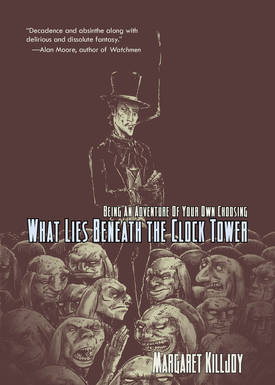The Choose Your Own Adventure series comprised a large portion of my childhood reading. There was nothing more exciting than having the fate of say, James Bond, within your page-flipping fingers, and I have found myself longing for adult versions of the reading game. Thankfully, I’m not alone and several clever and fun Choose Your Own Adventure riffs have trickled throughout the years, like Emma Webster’s Lost in Austen, and Margaret Killjoy‘s What Lies Beneath The Clock Tower: A Steampunk Adventure of Your Own Choosing, out through Combustion Books.
Clock Tower smartly revamps the make your own adventure recipe with a fantasy base flavored with a pinch of Steampunk and a splash of politics. The plot is this: lead the foppish, British rake Gregory from decadent indolence in fin-de-siècle France to “the depths of the undercity” where Gregory is involved in warfare between “colonialist gnomes” and “indigenous goblins.” There’s action and absinthe, difference engines and monsters, romance and of course, zeppelins.
It is a fun read, not only engaging, but also enlightening. It is a story about class warfare, capitalism, oppression, revolution, and most of all free will.
Naturally, I died within the first few pages, and doing only what an avid CYOA reader would do, began cheating until I successfully completed the book. It sounds pitiful, but it was actually more fun that way because I began to see exactly how Clock Tower is different than your typical CYOA. I remember the CYOA as having one arc unifying the whole, and any diverging path led to failure and end game. While you as a reader choose pivotal actions of the character, the choice is not a free one, but rather a fork in the road of the already pre-determined story. The odds are 50/50; right or wrong.
Killjoy revamps this medium and exploits it to its full potential by blurring the 50/50 pre-determined Fate of the hero into a multi-faced sport of free will. Clock Tower has several subplots you can follow, and more than one path to doom or glory. Granted a lot of the choices end in demise, but death isn’t necessarily the sad ending it connotes. You can choose to die a coward, or a hero. Or, if you do successfully complete the story, it isn’t necessarily by honest means. Every decision has consequence and an attached moral when read closely.
This nuance of Clock Tower is not surprising giving its author is a passionate advocate for political and philosophical discourse within genre literature. Margaret Killjoy’s literary career has been devoted to promoting his DIY political and philosophical ideas in such publications as STEAMpunk magazine, which he founded and is now being run out of the UK, through the collective Indy press Combustion Books, his blog Anarchist Fiction.net, and his newest magazine Graceless: A Journal of the Radical Gothic (just to name a few of his projects). Wanting to understand more about what went into the making of this unusual book, I was fortunate enough to get to interview Killjoy via e-mail.
S. J. Chambers: Where did you get the idea for a Choose Your Own Adventure book?
Margaret Killjoy: You know, I grew up reading Choose Your Own Adventure books, maybe in part because I didn’t have any friends I could play role-playing games with. I loved all the directions the story could take, and I always reread them so many times to try to find all the nooks and crannies I’d left unexplored. So, years later, I was bored on an Amtrak and procrastinating some other work when I decided to start Clock Tower. I assumed it would be light and easy to write, and the first few thousand words came effortlessly. After that it got harder, of course.
SJC: If I recall my childhood reading correctly, those CYOA books did have a specific ending the reader was aiming towards. However, in Clock Tower, there are in fact many endings, and not just one overarching plot-goal. Is that correct, or do I just suck at choosing my own adventure? Is there a deeper philosophical/literary implication in that decision to have myriad endings, some good as well as bad?
MK: Inasmuch as one can with a plot like “involve yourself in the anti-colonial struggle of goblins and gnomes,” I tried for realism, at least from the point of view of plotting. I wanted to play with the concept of free will: the protagonist can choose to involve themselves in a number of ways, and honestly there are a lot of bad choices that can be made. And on top of that, intelligent choices, from an individual point of view, don’t really exist when we’re talking about something as dangerous as revolution: when you go to war, the odds are good that you’re not going to fare well.
Further, there is a colonialist trope that I hoped to counter, that of the privileged white hero who comes in and saves all the little oppressed people. I aimed, instead, to offer the protagonist a chance to throw his lot in with another culture’s oppressed classes, as an autonomous equal.
 SJC: What was your process in writing such a non-linear, multi-plot book?
SJC: What was your process in writing such a non-linear, multi-plot book?
MK: I started it by just plowing into it and making forks, following one path to its end before backing up and finishing off each fork back up the chain, but after nearly 30,000 words and several months of work, I started over. One night I had an epiphany and I said to my then-partner, “The book is all wrong, the character is all wrong. It’s too convoluted and I’m sick of every story being from the point of view of the all-powerful leader of vast armies. I’d rather see through the eyes of the poor schmoe wrapped up in it all.” Of course, we’d been sort of planning on selling Clock Tower in order to eat food that winter, but I started over regardless.
So I plotted out the entire book first. I drew a tree of every major path and choice, and then slowly worked my way through each path. This helped put equal weight on all five major plotlines, and I set out to make each one as fulfilling as possible.
There are a lot of things you have to be really careful about when writing a book like this. I need to, for example, describe the goblins the first time you see them no matter which path you’re on. Keeping track of what information has been given to the reader at what point was one of the biggest challenges.
SJC: Is Clock Tower having a bit of fun at Steampunk and the current trend of Victoriana Fantasy? Why fin-de-siècle France?
MK: I was consciously picking on revolutionists and exploring the frustrations of being an activist (if you find your way to the Gnomish Aboveground, you’ll know what I mean), but I think I’d intended my steampunk at least to be earnest (although obviously silly). The character is an expatriate in part because I wanted to show how he hadn’t even bothered to learn French, and of course so I could make allusions to the Paris commune.
SJC: Speaking of revolutions, one of the most interesting things to me about your work, and in this book, is the anarchist principles you explore in genre. Would you mind explaining what those principles are that you explore (class, status, etc.) and what it is about genre literature that you think lends itself well to anarchist principles?
MK: I would wager that anarchism is one of the most misunderstood political ideologies of our day.
My favorite quote describing anarchism actually comes from Ursula K. Le Guin, from her “The Day Before The Revolution,” a story in the same timeline as her more well-known anarchist novel The Dispossessed. The quote is “[An anarchist] is one who, choosing, accepts the responsibility of choice.”And what that means to me is that both freedom—choice—and responsibility are important and what we should strive for as both individuals and as society. A bit more explicitly, anarchism is a political tradition—broader than most people realize—that espouses anti-capitalist and anti-state beliefs. In this case, I would most quickly describe capitalism as the ability to make money with money—capital—instead of work, and the state as a centralized form of government that is authoritarian and has rigid boundaries.
My political beliefs are inseparable from my work, that’s true. I think that any author’s beliefs will find their way into their writing, even if just by writing yet another work that reinforces the status quo: the straight white male protagonist who follows hierarchy unquestioningly. But what I find so beautiful and useful about genre writing is that fiction is a terrible way to tell anyone what to do—utopian fiction with perfect characters is boring—but a remarkably interesting way to ask questions. I’ve no interest in tricking or forcing anyone into thinking anything, and much more interest in offering ideas to be accepted or rejected by readers. And genre fiction is even better for this, since it lets us see things in a fantastical way, giving us an infinite sandbox within which to play.
S. J. Chambers is no stranger to steampunk adventure. She is co-author with Jeff Vandermeer of the critically acclaimed The Steampunk Bible (Abrams Image). She edits the book’s sister site Volume 2.0., as well as helms the Articles ship at Strange Horizons magazine. You can find her entertaining in her Internet salon The Flightless Philosopher and quipping on Twitter.










